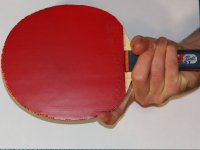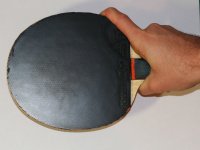
In the Seemiller grip, the racket is held similarly to the shakehand grip, but with a 90 degree turn so that the thumb and index finger are used to grip the sides of the bat. Both forehand and backhand are played with the same side of the bat, although the bat can be turned to use the other side. It is typically used with a combination bat.
This grip is named after Dan Seemiller, who first popularized the grip in the 1970’s, and enjoyed world level success with it.
Advantages
The Seemiller grip allows good wrist movement on the forehand stroke, giving a powerful forehand topspin. It is also good for blocking on both sides.
Because the one side of the bat is used for both forehand and backhand, the grip does not have the problem of a crossover point that the shakehands grip has.

Most players will put a long pimpled or antispin rubber on the back of the bat, and occasionally turn their wrist over to use the backside of the bat to provide extra variation in their returns.
Disadvantages
The amount of wrist movement is hampered on the backhand side, limiting the ability to topspin the ball heavily, or hit with great power.
Also, since the introduction of the two-color rule, the advantages gained by turning the racket to use the back side are much less than before.
What Type of Player Uses This Grip?
This grip is commonly used by attacking style players who prefer to play with a strong forehand topspin and steady backhand, with occasional variations in play caused by turning their wrist to use the rubber on the back of the bat. Players who prefer to block and counterhit from both sides can also find this grip to their liking.
The Seemiller grip is relatively out of favour at the highest levels of the game in recent years.

